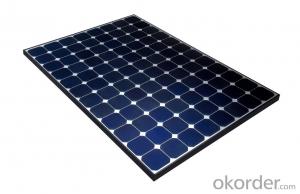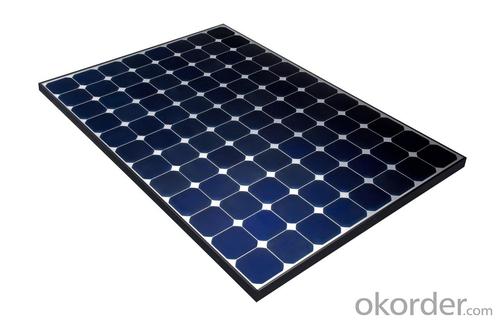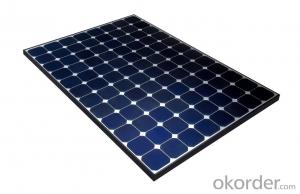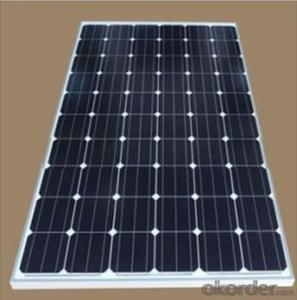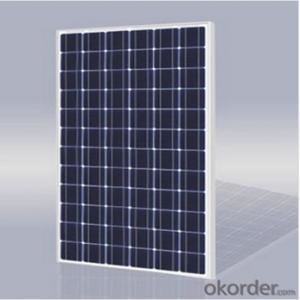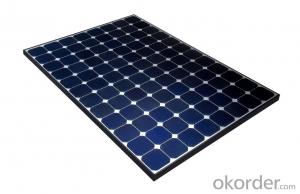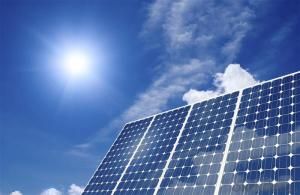Small Scale Solar Energy Systems:200kw CNBM Monocrystalline Silicon Panel for Home Use
- Loading Port:
- Tianjin
- Payment Terms:
- TT OR LC
- Min Order Qty:
- 15 watt
- Supply Capability:
- 1000 watt/month
OKorder Service Pledge
OKorder Financial Service
You Might Also Like
Specification
200KW CNBM Monocrystalline Silicon Panel for Home Using
Production description
he price of solar power, together with batteries for storage, has continued to fall so that in many countries it is cheaper than ordinary fossil fuel electricity from the grid (there is "grid parity"). For example in 2015, an average home in Europe or the US could use around 3,000 kilowatt-hour (kWh) in electricity each year.[1] Twelve 280 watt solar PV modules (each generating 250 kWh annually) would generate at least 3,000 kWh each year, even in a cloudy country like the UK. An example market price would be about £8,000 in the UK, $12,000 in the US, or €10,000 in theEurozone in 2015, which is certain to continually fall,[2] allowing permanent energy independence for each household. Most governments have feed-in tariff systems that allow homeowner to sell surplus energy back into the grid, and make a future profit on their investment.Off-the-grid homes are autonomous; they do not rely on municipal water supply, sewer, natural gas, electrical power grid, or similar utility services. A true off-grid house is able to operate completely independently of all traditional public utility services. The idea has been recently popularized by certain celebrities including Ed Begley, Jr.[1] who stars in Living with Ed[2] television show on the Home & Garden Television (HGTV) network. Actress Daryl Hannahpromotes off-grid living and constructed her home in Colorado according to those principles, as does survival expert and Dual Survival co-star Cody Lundin,[3]who lives in a self-designed, passive solar earth house in the high-desert wilderness of Northern Arizona, collecting rainwater, composting waste, and paying nothing for utilities.[4][5]
Electrical power can be generated on-site with renewable energy sources such as solar (particularly with photovoltaics), wind, micro hydro, geothermal; with agenerator or Micro combined heat and power with adequate fuel reserves. Such a system is called a stand-alone power system. In addition, it is possible to simply eliminate electric power such as in Old Order Amish and Old Order Mennonite communities.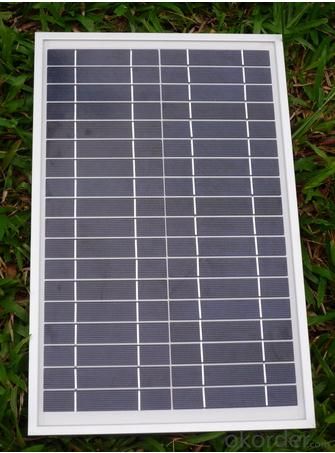
Feature
1.High conversion efficiencies resulting in superior power output performance.
2.Outstanding power output even in low light or high temperature conditions
3.Optimized design for ease of soldering and lamination
Physical characteristic
1. Rigorous quality control meets the highest international standards.
2. High-transmissivity low-iron tempered glass, strong aluminium frame.
3. Using UV-resistant silicon.
4. IS09001/14001/CE/TUV/UL
Packaging
26pcs in one carton 6pallets in 20foot container 14pallets in 40 foot container.
- Q: Are there any noise concerns associated with solar energy systems?
- Yes, there are minimal noise concerns associated with solar energy systems. Unlike traditional energy sources such as generators or wind turbines, solar panels do not produce any noise while generating electricity. This makes solar energy systems a quiet and peaceful option for harnessing renewable energy.
- Q: Are there any tax credits available for installing a solar energy system?
- Yes, there are tax credits available for installing a solar energy system. The federal government offers a Solar Investment Tax Credit (ITC) that allows homeowners and businesses to deduct a percentage of the system's cost from their taxes. Additionally, some states and local governments may also offer their own tax incentives for solar installations.
- Q: Do solar energy systems require regular maintenance?
- Yes, solar energy systems do require regular maintenance. This includes cleaning the solar panels, checking for any damage or debris, and inspecting the overall system performance. Regular maintenance ensures optimal efficiency and longevity of the solar energy system.
- Q: Can I install solar panels myself?
- Yes, it is possible to install solar panels yourself, but it requires a certain level of expertise and knowledge in electrical work and roofing. It is recommended to hire a professional installer who is trained and experienced in handling solar panel installations to ensure safety and optimal performance.
- Q: Can solar energy systems be used in space exploration?
- Solar energy systems are indeed utilized in space exploration. In the demanding conditions of space, solar energy proves to be a dependable and renewable power source. Satellites and spacecraft commonly employ solar panels to generate electricity for their diverse systems and instruments by harnessing sunlight and converting it into electricity through the photovoltaic effect. One of the primary benefits of employing solar energy in space exploration lies in its abundance. The sun offers an essentially limitless energy source that can be accessed throughout the entire solar system. Consequently, solar power becomes an appealing option for lengthy missions where alternatives like batteries or fuel cells would be impractical. Moreover, solar energy systems possess the advantage of being lightweight and scalable, making them an ideal choice for space applications. This is vital due to the significant concern over weight during space missions, given the exorbitant cost of launching objects into space. Solar panels can be conveniently packed and deployed, presenting a compact and efficient solution for power generation. Furthermore, solar energy exhibits its superiority as a clean and sustainable power source. Unlike traditional fuel-based systems, solar energy does not emit harmful substances or generate waste, making it crucial for maintaining spacecraft cleanliness and minimizing environmental impact. However, it is important to acknowledge the limitations of solar energy systems in space. For missions beyond the Mars orbit, where sunlight is notably diminished, alternative power sources like nuclear energy or fuel cells may prove more suitable. Nonetheless, solar energy remains a vital and extensively employed technology in space exploration, playing a key role in powering scientific experiments, communication systems, and other essential functions.
- Q: How do solar energy systems impact the reduction of nuclear power reliance?
- Solar energy systems can have a significant impact on reducing reliance on nuclear power by providing a clean and renewable alternative. As solar power becomes more accessible and affordable, it can help decrease the need for nuclear power plants, which often pose environmental and safety concerns. Additionally, solar energy systems can decentralize power generation, allowing individuals and communities to generate their own electricity and reduce their dependence on centralized nuclear facilities.
- Q: Do solar energy systems require maintenance?
- Yes, solar energy systems do require maintenance. Regular inspections, cleaning of solar panels, and occasional repairs or replacements of components may be necessary to ensure optimal performance and longevity of the system.
- Q: Can solar energy systems be used in powering research farms or agricultural laboratories?
- Yes, solar energy systems can certainly be used to power research farms or agricultural laboratories. Solar panels can generate electricity which can be used to power various equipment and machinery used in these facilities, such as irrigation systems, lighting, climate control systems, and other electrical devices. By utilizing solar energy, these agricultural facilities can reduce their reliance on fossil fuels and significantly lower their operational costs while also contributing to a more sustainable and environmentally friendly approach to farming and research.
- Q: Can a solar energy system be installed in areas with high seismic activity?
- Yes, a solar energy system can be installed in areas with high seismic activity. However, it is important to ensure that the system is designed and installed in a way that can withstand the potential impact of earthquakes. This may involve using specialized mounting systems, reinforcing structures, and conducting thorough assessments of the site's geological conditions. By following proper engineering practices and regulations, solar energy systems can be safely installed and operated in seismic-prone areas.
- Q: Can solar energy systems be used for powering remote weather stations?
- Certainly, remote weather stations can indeed utilize solar energy systems for power generation. Solar energy proves to be an eco-friendly and renewable power source, which can be effectively harnessed in isolated regions where it may not be feasible or cost-effective to connect to the electrical grid. The operation of weather stations necessitates a consistent supply of electricity to support their sensors, data loggers, communication devices, and other equipment. The installation of solar panels at these stations allows the capture of sunlight and its conversion into electricity through photovoltaic technology. This electricity can then be stored in batteries, thereby offering a dependable and sustainable power supply for the weather station, even during times of cloudy or nighttime conditions. Furthermore, solar energy systems entail minimal maintenance and possess a long lifespan, rendering them ideally suited for remote locations where regular maintenance visits may pose challenges. In general, the utilization of solar energy systems to power remote weather stations presents a practical and environmentally friendly solution that ensures the uninterrupted operation of these crucial monitoring facilities.
Send your message to us
Small Scale Solar Energy Systems:200kw CNBM Monocrystalline Silicon Panel for Home Use
- Loading Port:
- Tianjin
- Payment Terms:
- TT OR LC
- Min Order Qty:
- 15 watt
- Supply Capability:
- 1000 watt/month
OKorder Service Pledge
OKorder Financial Service
Similar products
Hot products
Hot Searches
Related keywords
